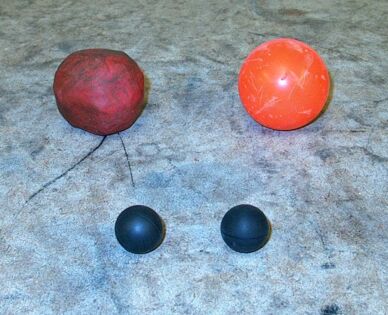
The photograph above shows in the top row, at left a ball of clay, and at right a rubber ball. The bottom row is a pair of rubber balls, one made of neoprene and one made of a special rubber called Norsorex® (polynorbornene). (These are sold by various scientific supply stores as a “happy” and a “sad,” or “unhappy,” ball.) When you drop the clay ball and the rubber ball on the floor, the rubber ball bounces back up, and the clay ball deforms and does not bounce. (It may roll a bit.) When you drop the neoprene (“happy”) and the polynorbornene (“sad”) ball, the neoprene ball bounces back up, but the ball made of polynorbornene hardly bounces at all. The collisions of the orange rubber ball and the neoprene ball with the floor are highly elastic, and those of the clay ball and the polynorbornene ball with the floor are highly inelastic.
In an elastic collision, both kinetic energy and momentum are conserved. As the objects involved in the collision are deformed, kinetic energy is converted to potential energy. To whatever extent the objects are deformed, they return to their original shape, and in doing so convert this potential energy back into kinetic energy. In a perfectly elastic collision, this conversion would be complete. No collision is perfectly elastic, however, and some kinetic energy is lost to heat.
In an inelastic collision, some kinetic energy is lost to permanent deformation of one or both of the colliding objects, or to heat. In a perfectly inelastic collision, the colliding objects stick together after collision. In such a collsion (as in all collisions) total energy and momentum are conserved.
When you drop either the orange rubber ball or the “happy” ball, its collision with the floor is mostly elastic, and the ball bounces most of the way back to the height from which you dropped it. When you drop the clay ball, it deforms on impact with the floor, and does not bounce at all (though it may roll a bit). When you drop the “sad” ball, it bounces up only a tiny distance from the floor. The collisions of both the ball of clay and the “sad” ball with the floor are highly inelastic. (The one with the “sad” ball is perhaps slightly less so than that with the ball of clay.) As noted above, for these collisions, both total energy and momentum are conserved. The floor, however (not to mention the building to which it is attached, and the earth, on which the building sits), is so much more massive than the balls, that we cannot perceive its motion when the balls transfer momentum to it in their inelastic collisions with it.